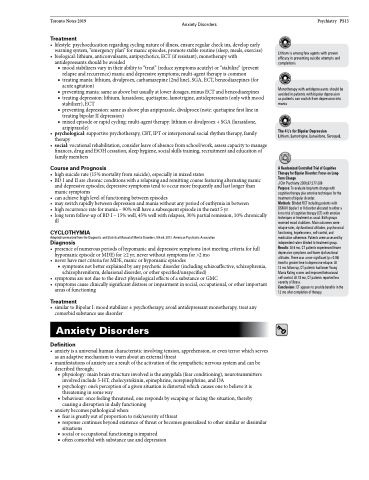Page 1177 - TNFlipTest
P. 1177
Toronto Notes 2019 Anxiety Disorders
Treatment
• lifestyle:psychoeducationregardingcyclingnatureofillness,ensureregularcheckins,developearly warning system, “emergency plan” for manic episodes, promote stable routine (sleep, meals, exercise)
• biological:lithium,anticonvulsants,antipsychotics,ECT(ifresistant);monotherapywith antidepressants should be avoided
■ mood stabilizers vary in their ability to “treat” (reduce symptoms acutely) or “stabilize” (prevent relapse and recurrence) manic and depressive symptoms; multi-agent therapy is common
■ treating mania: lithium, divalproex, carbamazepine (2nd line), SGA, ECT, benzodiazepines (for acute agitation)
■ preventing mania: same as above but usually at lower dosages, minus ECT and benzodiazepines
■ treating depression: lithium, lurasidone, quetiapine, lamotrigine, antidepressants (only with mood
stabilizer), ECT
■ preventing depression: same as above plus aripiprazole, divalproex (note: quetiapine first line in
treating bipolar II depression)
■ mixed episode or rapid cycling: multi-agent therapy: lithium or divalproex + SGA (lurasidone,
aripiprazole)
• psychological:supportivepsychotherapy,CBT,IPTorinterpersonalsocialrhythmtherapy,family
therapy
• social:vocationalrehabilitation,considerleaveofabsencefromschool/work,assesscapacitytomanage
finances, drug and EtOH cessation, sleep hygiene, social skills training, recruitment and education of family members
Course and Prognosis
• highsuiciderate(15%mortalityfromsuicide),especiallyinmixedstates
• BDIandIIarechronicconditionswitharelapsingandremittingcoursefeaturingalternatingmanic
and depressive episodes; depressive symptoms tend to occur more frequently and last longer than
manic symptoms
• can achieve high level of functioning between episodes
• mayswitchrapidlybetweendepressionandmaniawithoutanyperiodofeuthymiainbetween
• highrecurrencerateformania–90%willhaveasubsequentepisodeinthenext5yr
• longtermfollow-upofBDI–15%well,45%wellwithrelapses,30%partialremission,10%chronically
ill
CYCLOTHYMIA
Adapted/summarized from the Diagnostic and Statistical Manual of Mental Disorders, 5th ed. 2013. American Psychiatric Association
Diagnosis
• presenceofnumerousperiodsofhypomanicanddepressivesymptoms(notmeetingcriteriaforfull hypomanic episode or MDE) for ≥2 yr; never without symptoms for >2 mo
• neverhavemetcriteriaforMDE,manicorhypomanicepisodes
■ symptoms not better explained by any psychotic disorder (including schizoaffective, schizophrenia,
schizophreniform, delusional disorder, or other specified/unspecified)
• symptomsarenotduetothedirectphysiologicaleffectsofasubstanceorGMC
• symptomscauseclinicallysignificantdistressorimpairmentinsocial,occupational,orotherimportant
areas of functioning
Treatment
• similartoBipolarI:moodstabilizer±psychotherapy,avoidantidepressantmonotherapy,treatany comorbid substance use disorder
Anxiety Disorders
Definition
• anxietyisauniversalhumancharacteristicinvolvingtension,apprehension,oreventerrorwhichserves as an adaptive mechanism to warn about an external threat
• manifestationsofanxietyarearesultoftheactivationofthesympatheticnervoussystemandcanbe described through;
■ physiology: main brain structure involved is the amygdala (fear conditioning); neurotransmitters involved include 5-HT, cholecystokinin, epinephrine, norepinephrine, and DA
■ psychology: one’s perception of a given situation is distorted which causes one to believe it is threatening in some way
■ behaviour: once feeling threatened, one responds by escaping or facing the situation, thereby causing a disruption in daily functioning
• anxietybecomespathologicalwhen:
■ fear is greatly out of proportion to risk/severity of threat
■ response continues beyond existence of threat or becomes generalized to other similar or dissimilar
situations
■ social or occupational functioning is impaired
■ often comorbid with substance use and depression
Psychiatry PS13
Lithium is among few agents with proven efficacy in preventing suicide attempts and completions
Monotherapy with antidepressants should be avoided in patients with bipolar depression as patients can switch from depression into mania
The 4 L’s for Bipolar Depression
Lithium, Lamotrigine, Lurasidone, SeroqueL
A Randomized Controlled Trial of Cognitive Therapy for Bipolar Disorder: Focus on Long- Term Change
J Clin Psychiatry 2006;67:277-286
Purpose: To evaluate long-term change with cognitive therapy plus emotive techniques for the treatment of bipolar disorder.
Methods: Blinded RCT including patients with DSM-IV bipolar I or II disorder allocated to either a 6 mo trial of cognitive therapy (CT) with emotive techniques or treatment as usual. Both groups received mood stabilizers. Main outcomes were relapse rates, dysfunctional attitudes, psychosocial functioning, hopelessness, self-control, and medication adherence. Patients were assessed by independent raters blinded to treatment group. Results: At 6 mo, CT patients experienced fewer depressive symptoms and fewer dysfunctional attitudes. There was a non-significant (p=0.06) trend to greater time to depressive relapse. At
12 mo follow-up, CT patients had lower Young Mania Rating scores and improved behavioural self-control. At 18 mo, CT patients reported less severity of illness.
Conclusions: CT appears to provide benefits in the 12 mo after completion of therapy.


